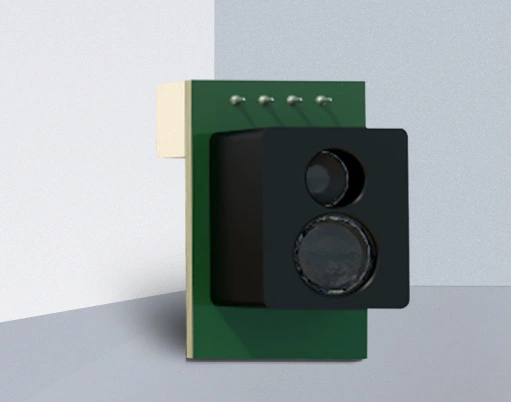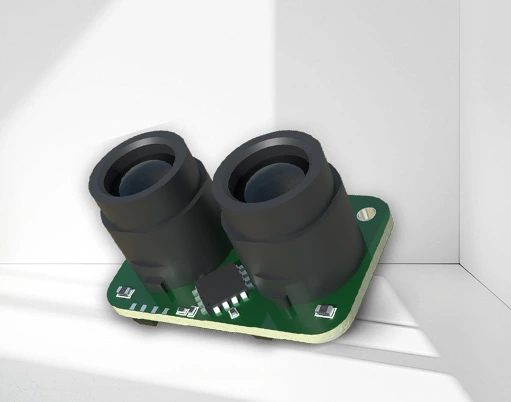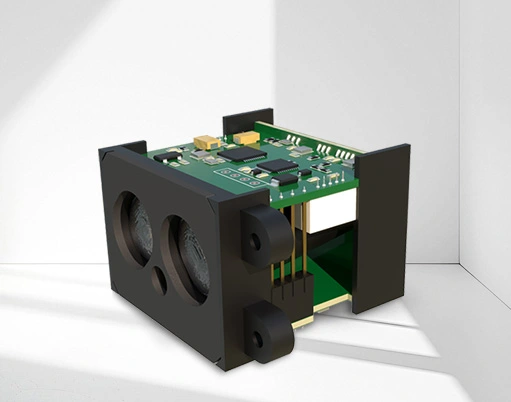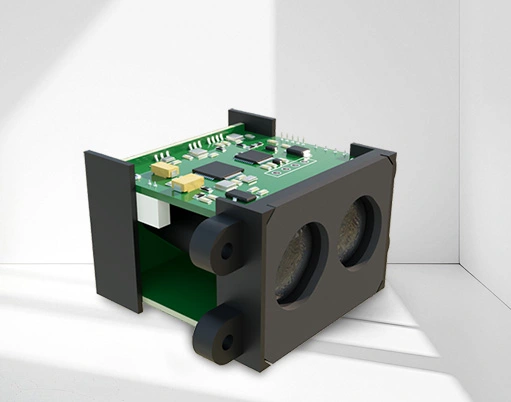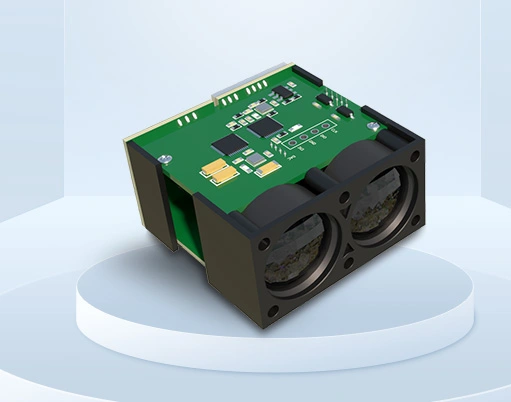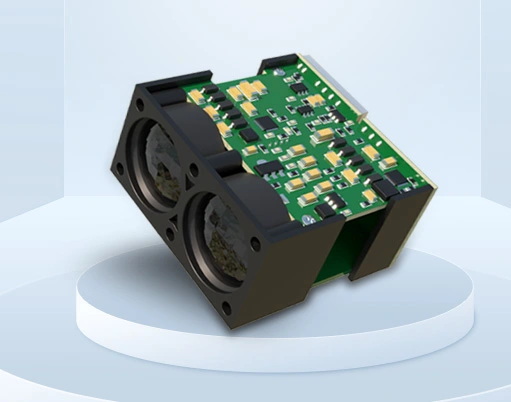In the field of industrial production and warehousing, level monitoring of bulk cargo (such as coal, grains, ores, plastic pellets, etc.) is a key link to ensure production continuity and improve warehousing efficiency. Time of Flight (ToF) laser ranging sensors have become an ideal choice for bulk cargo level monitoring due to their advantages of non-contact measurement, high precision, and strong anti-interference ability. It indirectly calculates the level height by measuring the distance between the sensor and the surface of the bulk cargo, which can adapt to complex working conditions and achieve real-time data feedback. The following will explain the technical principles, system design, application points, and optimization solutions.
1、 Technical principle: Level calculation based on laser flight time
The core principle of ToF laser ranging sensor is to calculate the distance between the sensor and the measured object by measuring the time difference between the laser pulse emitted and reflected back by the target. The formula is:
Distance=(speed of light x time difference)/2
In bulk cargo level monitoring, sensors are usually installed at the top of the silo, and the laser beam is vertically directed downwards onto the surface of the bulk cargo. If the total height of the silo (the distance from the sensor installation position to the bottom of the silo) is known, thenLevel height=total height of silo - distance between sensor and bulk cargo surfaceFor example, if the total height of the silo is 10 meters and the sensor measures a distance of 3 meters from the surface of the material, then the current level height is 7 meters.
Compared to technologies such as ultrasound and radar, the advantages of ToF laser sensors are: strong laser directionality (small spot size), which can accurately focus on the surface of materials; Better ability to resist dust interference (by reducing scattering through specific wavelength lasers); High measurement accuracy (usually ± 1mm~± 5mm), especially suitable for high-precision level control scenarios.
2、 System Design: Hardware Selection and Layout
1. Key parameters for sensor selection
Measurement rangeAccording to the height of the silo, sensors with a range of 0.5-30 meters (such as SICK DT500 series) can be selected for small and medium-sized silos (5-20 meters); Large silos (20-100 meters) require industrial grade sensors with a range of up to 150 meters (such as Leuze BCL 300).
spot sizeThe surface of bulk cargo is usually uneven (such as slopes formed by coal accumulation), and sensors with gradually increasing spot diameter with distance (such as spot diameter ≤ 100mm at 10 meters) should be selected to avoid measurement deviation caused by local depressions/protrusions.
anti-interference ability:
Dust environment: Choose sensors with dust-proof lenses (IP67 protection) and anti scattering algorithms to reduce the scattering effect of dust on lasers;
Strong light environment: equipped with narrowband filters (such as 905nm infrared laser) to filter out interference from sunlight or workshop lighting;
Temperature and humidity: Industrial grade sensors need to withstand temperatures of -40 ℃~85 ℃ and 95% humidity (without condensation) to adapt to differences in the internal and external environment of the silo.
output interfacePriority should be given to selecting 4-20mA analog or EtherNet/IP digital interfaces for easy integration with PLC and SCADA systems, enabling data upload and automatic control.
2. Installation layout design
Installation position:
The sensor should be installed in the central area of the top of the silo, avoiding proximity to the feeding port (to prevent material splashing from blocking the lens) or the discharging port (to avoid measurement fluctuations caused by material flow impact);
Maintain a distance of at least 1 meter from the warehouse wall to reduce interference from reflections or dead corners of material accumulation.
Angle calibrationThe laser beam needs to be perpendicular to the bottom of the silo, with a tilt angle of ≤ 1 °, otherwise it needs to be compensated through software (based on the tilt angle to calculate the actual distance).
Protective measures:
Install a blowing device (compressed air) on the lens and regularly clean the dust;
The sensor housing is made of stainless steel material to resist the corrosion of bulk dust.
3、 Data processing and level calculation
1. Raw data filtering
The unevenness of the surface of bulk cargo (such as the undulations formed by particle accumulation) can cause fluctuations in measurement values, which need to be processed through algorithms:
median filtering Continuously collect 5-10 data points, remove the maximum and minimum values, and take the average to eliminate instantaneous interference;
Sliding window filteringSmooth continuous data with a window of 100ms, suitable for scenarios where materials are slowly changing (such as storage silos).
2. Level calculation and threshold setting
Basic calculationCalculate the level height (L=H-D) by comparing the real-time distance value (D) of the sensor with the total height of the silo (H), and convert it into a level percentage (L/H × 100%).
Threshold warningPreset high/low level thresholds (such as 80% for full warehouse warning and 20% for low material warning), when the level reaches the threshold, trigger an alarm through PLC (such as sound and light prompts) or automatic control (such as starting the feed pump/stopping the discharge).
3. Special scenario handling
The impact of material resting angleBulk cargo accumulation can form a resting angle (such as a grain resting angle of about 30 °~40 °), causing the surface to tilt, and sensors may measure the slope rather than the highest level. Solution:
Multi sensor layout: Install 3-4 sensors at the top of the silo, and take the minimum value (corresponding to the highest material point) as the valid data;
Algorithm correction: Based on the material resting angle model, perform tilt compensation on single sensor data.
Material splashing/dustDuring feeding, material splashing or dust may obstruct the laser, resulting in measurement failure. The "delayed measurement" mechanism can be used: pause the measurement during the feeding process and restart it after the material stabilizes (such as delaying for 5 seconds) to avoid invalid data.
4、 Application Cases and Optimization Solutions
1. Typical application scenarios
grain storageInstall ToF sensors on the top of the grain silo to monitor the level height of wheat and corn in real time. When it is below 20%, trigger a replenishment command to avoid empty storage;
Industrial powder siloMonitor the levels of cement, plastic particles, and other materials, and transmit them to the DCS system through a 4-20mA signal to achieve automatic level adjustment and reduce manual inspection costs;
Ore material yardInstall laser sensors (with pan tilt) above large open-air material piles to scan the contour of the piles, calculate volume and level, and assist in inventory management.
2. Optimization strategy
periodic calibrationCalibrate sensors every 3 months using a benchmark of known height (such as hanging a 10 meter long ruler in a silo) to compensate for errors caused by temperature drift or lens contamination;
Redundant designKey workstations adopt dual sensor backup, which automatically switches to the backup sensor when the main sensor fails, ensuring system continuity;
Data visualizationDraw the level change curve through the SCADA system, analyze the material consumption rate, optimize the feeding/discharging rhythm, and reduce energy consumption.
conclusion
The time-of-flight laser ranging sensor provides a high-precision, non-contact solution for bulk cargo level monitoring. Its core advantage lies in adapting to complex working conditions (dust, vibration, high and low temperatures) and achieving real-time data feedback. By rational selection, scientific layout, and algorithm optimization, problems such as uneven surface of bulk cargo and dust interference can be effectively solved, meeting the high-precision and high reliability requirements for level monitoring in industrial production. With the development of industrial Internet of Things technology, this solution can be further integrated with cloud platforms to achieve remote monitoring and intelligent decision-making, promoting the intelligent upgrading of bulk cargo warehousing and production.

